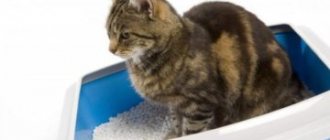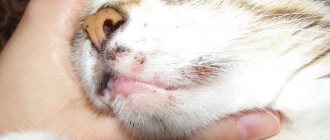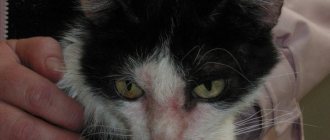Diseases of the urinary system are quite widespread both among people and in our pets. This is mainly due to the direct communication of this system with the environment, as well as the chemical aggressiveness of the secretions themselves. Urethritis is most often recorded in veterinary practice in cats. What it is and how dangerous this disease is, you can read in this article.
Types of discharge
Purulent vaginal discharge in a cat can occur for various reasons. Therefore, they are diverse and there is even a classification of them. Most of this discharge is very dangerous for the cat’s health, so you should always be careful about this disease. However, there are also reasons that cannot lead to serious illnesses.
In order to understand how serious and dangerous a pet’s discharge is, it is necessary to collect the clots and determine their nature. But this can only be done by a specialist; such an analysis can be carried out in a veterinary clinic. And only after this can the cause of the disease be more accurately determined and how it should be treated.
There are two types of cat discharge: dangerous and safe. Any purulent discharge requires treatment and the attention of a specialist. You should not treat your cat yourself, as this can only cause harm and aggravate the progression of the disease.
Prevention measures
The best prevention is to provide the animal with a proper lifestyle and a healthy diet. You should not abuse hormonal contraceptives (Antisex, Contrasex), since their long-term use causes hormonal disorders and provokes the development of diseases of the reproductive organs. Childbirth must be handled correctly, and if necessary, seek help from a clinic so that there are no sad consequences.
The best prevention is to sterilize the cat immediately after the first heat. The opinion that a cat that has given birth suffers less from uterine pathologies is erroneous. An owner who does not plan to breed kittens should sterilize the animal, and not feed it synthetic hormones every heat. Only sterilization completely rids a cat of diseases of the reproductive organs.
Discharge during pregnancy and childbirth
The owner should always be attentive to the cat during its pregnancy and especially during childbirth. Purulent discharge in a pregnant cat signals that something is going wrong in the body and the help of a specialist is needed.
It is known that during pregnancy and even during childbirth, clots form in cats, but they usually have either translucent shades or a greenish color. Their consistency is either similar to mucus, or it is a liquid of a certain color.
Causes of dangerous discharge
Dangerous purulent discharge in a cat always requires treatment and careful attention. There are several reasons for their occurrence. First of all, these are any types of infections, as well as various inflammations, cancer and other equally serious causes.
A pregnant cat always requires special attention, as complications may arise during childbirth, in which case part of the placenta remains inside the animal. Most often, purulent vaginal discharge in a cat indicates that the process of decomposition has begun in its body. To cure a sick animal, surgery is necessary.
Another reason may be an infectious disease of the genitals. If a cat has purulent discharge with a reddish tint, then most often this indicates that pathogenic processes are occurring in the animal’s uterus or in its bladder. They are easy to distinguish, since then such secretions do not have any odor, but are characterized by a peculiar and thick consistency. As soon as such signs appear in a cat, you should immediately contact a veterinarian.
Purulent discharge from a cat's loop, the treatment of which requires special attention, can also occur with cancer.
You should always pay attention to the smell of the discharge. Thus, a cat’s purulent discharge from the loop (vagina) has a peculiar smell, which will indicate that destructive processes are taking place in the cat’s body.
The cause of discharge with pus can also be inflammatory processes of the mucous membranes. You should carefully monitor your cat's behavior, as at this time she becomes restless and even aggressive. Can lick itself often and for a long time. Such a cat will be reluctant to go to the toilet, so it will show aggression and behave anxiously. This is due to the fact that she experiences pain when urinating.
If there was an injury to the bladder or uterus, then the cat may also have purulent discharge. Any injury to an animal will be accompanied by discharge, so the owner must provide it with immediate medical attention.
How to treat urethritis in a cat
At the first signs of illness, you must immediately show the cat to a veterinarian. Only he can correctly diagnose the disease and prescribe medication. To reliably determine the presence of urethritis, it is enough to take a general urine test. In this case, the number of red blood cells will be increased, and protein may be present in the urine.
Once the diagnosis is made, drug therapy is prescribed. The veterinarian may recommend washing the urethra with a warm solution of potassium permanganate or furatsilin. To facilitate urination, antispasmodics (No-shpa, Papaverine), as well as antihistamines (Fenkarol, Suprastin or Biseptol), are used.
Diuretics and disinfectants must be used. Often, for urethritis, an antibacterial drug containing silver ions is prescribed - Argumistin. It is introduced directly into the urethral cavity using a catheter. This should only be done by a highly qualified specialist in a clinical setting. It is important to begin treatment of the disease as early as possible to prevent complications.
For urethritis, veterinarians often use the drug Argumistin.
Endometritis
Purulent discharge from the uterus in a cat should always alert the owner. Sometimes the cause of such processes in the animal’s body is endometritis, which can manifest itself in two forms. The first form is chronic, in which it is usually impossible to detect the disease in a timely manner, since the cat behaves quite normally.
The acute form of this disease negatively affects the condition of the animal; it does not show any interest in the surrounding world. With this disease, a four-legged friend not only shows apathy, but also lacks appetite. If you do not consult a doctor with this form of the disease, the cat may die.
Clinical signs
What are the symptoms of this disease? Firstly, the animal cannot go to the toilet for a long time, constantly sitting on the tray. Meanwhile, the cat begins to run “to the potty” more and more often (due to the constantly irritated mucous membrane of the urethra). Gradually, the process of urination becomes extremely painful; the animal literally “screams obscenities” while trying to urinate. In those droplets of urine that the unfortunate cat managed to “express”, you can see blood, pus, and other evidence of a developed inflammatory process in his body. If you do not contact a veterinarian, the animal's condition will quickly deteriorate. An increase in general body temperature is possible, the cat’s appetite completely disappears, but excessive thirst appears. He will lap up the water from the bowl with noise and squelching, only to rush back to his tray within a few seconds.
Symptoms of serious intoxication of the body gradually appear: a strong smell of ammonia or even acetone comes from the skin and secretions of the animal, and copious amounts of saliva are observed. The cat is weakening before our eyes, preferring to hide in the most secluded, dark corners. It is important to say here that all of the above is so clearly manifested only in the case of acute urethritis, when the patency of the urinary canal is impaired. Fortunately, such severe urethritis in cats does not always occur. Sometimes the inflammation becomes chronic, and therefore the cat can urinate, as a result of which such severe intoxication does not develop. But you should still be wary of the fact that he often visits the tray, where the pet sits for a very long time.
Pyometra
One of the causes of the disease in cats can be pyometra. Most often, it manifests itself in the fact that mucous and purulent discharge comes from the cat’s vagina. They can be of different colors: brown, white or red. When the disease occurs in an open form, the main symptom is the expansion of the genital organs.
If this disease develops into a more complex form, then there will be no more clots. This is due to the fact that all the purulent masses gradually accumulate in the cat’s body and negatively affect its body and the functioning of individual organs. If you consult a doctor at an early stage of the disease, then there is a chance to save the cat. At a late stage of the disease, the animal’s uterus is already closed, intoxication occurs in the body, and there is practically no chance of salvation. Most often, late stages of the disease lead to the death of the animal.
Treatment of purulent discharge
Purulent discharge in a cat is a reason to consult a doctor. In addition, alarming symptoms include:
- the cat constantly tries to lick the crotch;
- abdominal consolidation;
- poor appetite;
- complete indifference of the animal to what is happening around.
The veterinarian will definitely perform a thorough examination of the cat, and he will also take a smear from the purulent lesion for examination. To make a diagnosis, the animal will undergo all the necessary procedures: ultrasound, tests.
For each type of disease, its own treatment is prescribed, which can only be determined by a specialist. The easiest way to treat purulent discharge in a cat is to take antibiotics. If the discharge is too active, then only a doctor can decide on surgical intervention. This is required if it is necessary to remove infected organs. You should not treat your cat with folk remedies, as this can only worsen the course of the disease and even lead to the death of the animal.
Diagnostic methods
For any complaints, it is necessary to take a general blood and urine test. An increased number of leukocytes in the blood will indicate the presence of an inflammatory process. Changes in urine values indicate an infection in the kidneys. With cystitis, protein, epithelial cells, mucus and salt crystals are found in the urine. An additional test for cystitis is cystoscopy - checking the functioning of the bladder with a special device.
Thickening of the uterine walls can be determined by palpation, so the veterinarian should feel the sick kitten. Additionally, an ultrasound procedure may be required. An ultrasound examination of the abdominal cavity will show changes in the walls of the uterus (thickening or thinning), accumulation of fluid in the organ, absence or presence of pregnancy, as well as existing tumors. Analysis of vaginal discharge may be required.
Anamnesis is collected and the animal is examined, identifying additional clinical symptoms. Your veterinarian may order the following tests:
- Standard or detailed urine and blood analysis.
- Bacterial culture to identify the pathogen.
- Vaginoscopy.
- X-ray or ultrasound of the abdominal cavity.
- Biopsy with cytological examination.
- Serological tests.
Preparing for surgery











